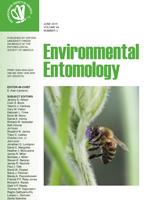The polyphagous navel orangeworm, Amyelois transitella (Walker) (Lepidoptera: Pyralidae), is the most destructive pest of nut crops, including almonds and pistachios, in California orchards. Management of this insect has typically been a combination of cultural controls and insecticide use, with the latter increasing substantially along with the value of these commodities. Possibly associated with increased insecticide use, resistance has been observed recently in navel orangeworm populations in Kern County, California. In studies characterizing a putatively pyrethroid-resistant strain (R347) of navel orangeworm, susceptibility to bifenthrin and β-cyfluthrin was compared with that of an established colony of susceptible navel orangeworm. Administration of piperonyl butoxide and S,S,S-tributyl phosphorotrithioate in first-instar feeding bioassays with the pyrethroids bifenthrin and β-cyfluthrin produced synergistic effects and demonstrated that cytochrome P450 monooxygenases and carboxylesterases contribute to resistance in this population. Resistance is therefore primarily metabolic and likely the result of overexpression of specific cytochrome P450 monooxygenases and carboxylesterase genes. Resistance was assessed by median lethal concentration (LC50) assays and maintained across nine generations in the laboratory. Life history trait comparisons between the resistant strain and susceptible strain revealed significantly lower pupal weights in resistant individuals reared on the same wheat bran-based artificial diet across six generations. Time to second instar was greater in the resistant strain than the susceptible strain, although overall development time was not significantly different between strains. Resistance was heritable and may have an associated fitness cost, which could influence the dispersal and expansion of resistant populations in nut-growing areas in California.
How to translate text using browser tools
1 June 2015
Mechanism of Resistance Acquisition and Potential Associated Fitness Costs in Amyelois transitella (Lepidoptera: Pyralidae) Exposed to Pyrethroid Insecticides
Mark Demkovich,
Joel P. Siegel,
Bradley S. Higbee,
May R. Berenbaum
ACCESS THE FULL ARTICLE
It is not available for individual sale.
This article is only available to subscribers.
It is not available for individual sale.
It is not available for individual sale.

Environmental Entomology
Vol. 44 • No. 3
June 2015
Vol. 44 • No. 3
June 2015
Amyelois transitella
detoxification
insecticide
pyrethroid
resistance




